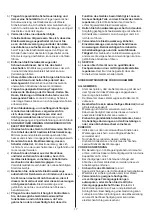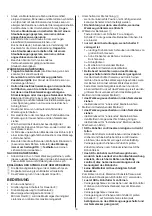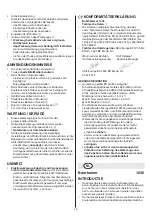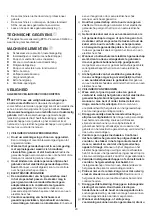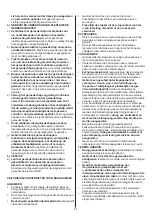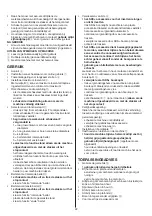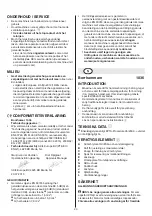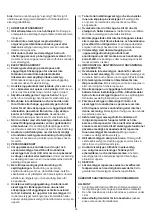
9
b)
Avoid body contact with earthed or grounded
surfaces such as pipes, radiators, ranges and
refrigerators.
There is an increased risk of electric
shock if your body is earthed or grounded.
c)
Do not expose power tools to rain or wet
conditions.
Water entering a power tool will increase
the risk of electric shock.
d)
Do not abuse the cord. Never use the cord for
carrying, pulling or unplugging the power tool.
Keep cord away from heat, oil, sharp edges or
moving parts.
Damaged or entangled cords increase
the risk of electric shock.
e)
When operating a power tool outdoors, use an
extension cord suitable for outdoor use.
Use of a
cord suitable for outdoor use reduces the risk of electric
shock.
f)
If operating a power tool in a damp location is
unavoidable, use a residual current device (RCD)
protected supply.
Use of an RCD reduces the risk of
electric shock.
3) PERSONAL SAFETY
a)
Stay alert, watch what you are doing and use
common sense when operating a power tool. Do
not use a power tool while you are tired or under
the influence of drugs, alcohol or medication.
A
moment of inattention while operating power tools may
result in serious personal injury.
b)
Use personal protective equipment. Always wear
eye protection.
Protective equipment such as dust
mask, non-skid safety shoes, hard hat, or hearing
protection used for appropriate conditions will reduce
personal injuries.
c)
Prevent unintentional starting. Ensure the switch
is in the off-position before connecting to power
source and/or battery pack, picking up or carrying
the tool.
Carrying power tools with your finger on the
switch or energising power tools that have the switch on
invites accidents.
d)
Remove any adjusting key or wrench before turning
the power tool on.
A wrench or a key left attached to
a rotating part of the power tool may result in personal
injury.
e)
Do not overreach. Keep proper footing and balance
at all times.
This enables better control of the power
tool in unexpected situations.
f)
Dress properly. Do not wear loose clothing or
jewelry. Keep your hair, clothing and gloves away
from moving parts.
Loose clothes, jewelry or long hair
can be caught in moving parts.
g)
If devices are provided for the connection of dust
extraction and collection facilities, ensure these are
connected and properly used.
Use of dust collection
can reduce dust-related hazards.
4) POWER TOOL USE AND CARE
a)
Do not force the power tool. Use the correct power
tool for your application.
The correct power tool will
do the job better and safer at the rate for which it was
designed.
b)
Do not use the power tool if the switch does not
turn it on and off.
Any power tool that cannot be
controlled with the switch is dangerous and must be
repaired.
Rotary hammer
1036
INTRODUCTION
•
This tool is intended for hammer drilling in concrete,
brick and stone as well as for light chiseling work;
for drilling in wood, metal and plastic as well as for
screwdriving specific accessories should be used
•
The hammering system in this tool outperforms any
traditional ratcheting drill when drilling in concrete
•
This tool is not intended for professional use
•
This tool is designed for use in combination with all
standard SDS+ accessories
•
Read and save this instruction manual
3
TECHNICAL DATA
1
.
Impact energy per stroke according to EPTA-Procedure
05/2009 -> value not available yet
TOOL ELEMENTS
2
A
Switch for on/off and speed control
B
Wheel for maximum speed control
C
Button for switch locking
D
Lever for changing direction of rotation
E
Unlocking button
F
Switch for selecting operating mode
G
SDS+ chuck
H
Keyless chuck
J
Locking sleeve
K
Auxiliary handle
L
Ventilation slots
SAFETY
GENERAL SAFETY INSTRUCTIONS
WARNING! Read all safety warnings and all
instructions.
Failure to follow the warnings and instructions
may result in electric shock, fire and/or serious injury.
Save
all warnings and instructions for future reference.
The
term "power tool" in the warnings refers to your mains-
operated (corded) power tool or battery-operated (cordless)
power tool.
1) WORK AREA SAFETY
a)
Keep work area clean and well lit.
Cluttered or dark
areas invite accidents.
b)
Do not operate power tools in explosive
atmospheres, such as in the presence of flammable
liquids, gases or dust.
Power tools create sparks
which may ignite the dust or fumes.
c)
Keep children and bystanders away while operating
a power tool.
Distractions can cause you to lose
control.
2) ELECTRICAL SAFETY
a)
Power tool plugs must match the outlet. Never
modify the plug in any way. Do not use any adapter
plugs with earthed (grounded) power tools.
Unmodified plugs and matching outlets will reduce risk
of electric shock.
2
1
ACCESSORIES
WWW.SKIL.COM
Summary of Contents for 1036
Page 2: ...2 1036 0 4700 850 3 6 kg 0 1020 2300 7 G L L H J F E L K C L D B A 1 2 ...
Page 3: ...3 3 4 5 6 8 9 7 ...
Page 4: ...4 2 1 5 2 1 A A q w e ...
Page 5: ...5 2 1 2 1 G r t ...
Page 6: ...6 2 1 1 1 1 1 J G H y u ...
Page 7: ...7 PHILLIPS HSS POZIDRIV SLOTTED K i o ...
Page 8: ...8 2 1 ACCESSORIES WWW SKIL COM s d p a ...
Page 110: ...110 ...
Page 117: ...117 2 1 WWW SKIL COM امللحقات s d p a ...
Page 118: ...118 PHILLIPS HSS POZIDRIV SLOTTED K i o ...
Page 119: ...119 2 1 1 1 1 1 J G H y u ...
Page 120: ...120 2 1 2 1 G r t ...
Page 121: ...121 2 1 5 2 1 A A q w e ...
Page 122: ...122 3 4 5 6 8 9 7 ...
Page 123: ...123 1036 0 4700 850 3 6 kg 0 1020 2300 7 G L L H J F E L K C L D B A 1 2 ...
Page 124: ...2610Z07197 07 15 1036 املطرقة كونينانبرج ڨ ب أروبا سكيل هولندا بريدا د ب ...

















